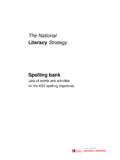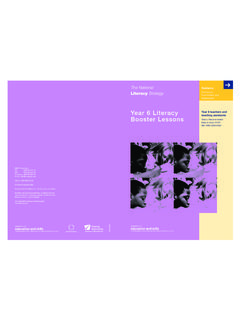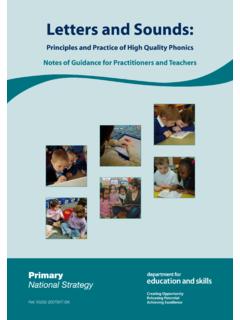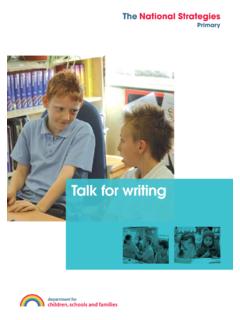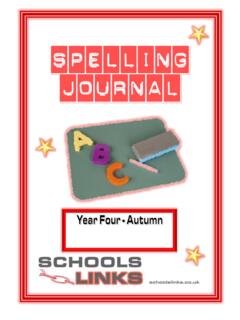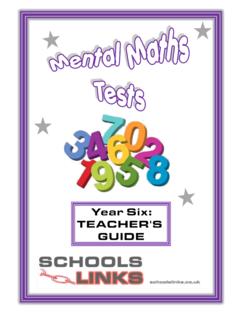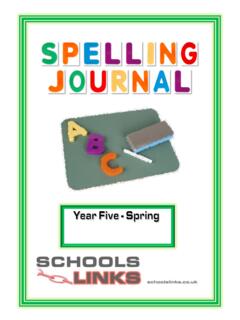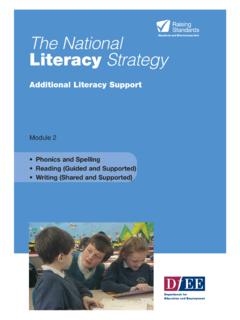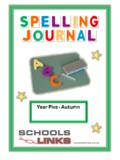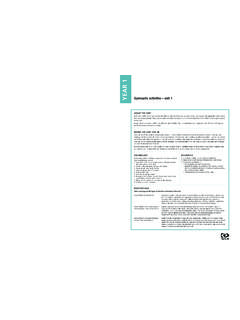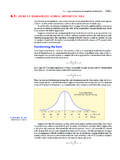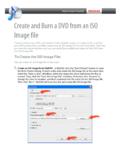Transcription of CD rom version revised
1 Phonics Progression in phonics: materials for whole-class teaching The National Literacy Strategy Department of Education and EmploymentSantuary BuildingsGreat Smith StreetLondon SW1P 3BT Crown copyright 1999 and 2000 Extracts from this document may be reproduced for non-commercial educational or training purposes on condition that the source 0 19 312246 4 ContentsPageIntroduction1 About this book9 Step 112 Steps 2 714 Phonic activities at each Step17 Instructions and bank of materials for activities18 Jingles18 Pebble Game18 Tray Game18 Match Me20 Circle Swap Shop20 Jump in the Hoop21 Mood Sounds21 Letter Formation21 Phoneme Frame22 Which of Two (or more)?23 Quickwrite24 North, South, East and West (NSEW)24 Flashcards25 Sock Puppets25 Noisy Letters25 Croaker26 Alien Game27 Finish It27 Fans28 Full Circle Game29 Sound Buttons30 Cube Game30 Silly Questions31 Phoneme Count32 Washing Line33 Bingo33 Rhyming Word Generation and Word Sort34 Split Digraph36 Photocopy masters (PCMs)37 IntroductionIt is widely accepted that successful reading depends on learning to use a rangeof strategies.
2 The reader uses these as cues to get to the meaning by predictingthe text, checking and cross-checking, identifying and correcting errors. Reading isby no means a passive process; it involves searching, problem-solving, activeprediction and an ability to bring past knowledge and experience to bear. Thispicture is familiar enough. It is built into the National Curriculum orders forreading, and forms the background against which successful literacy teaching hasbeen developed over the past 10 can represent this as a set of searchlights, each shedding light on the text:The reading searchlights modelSuccessful teaching equips children with as many of these searchlights aspossible. Each sheds a partial light but, together, they make a mutuallysupporting system. The fewer the searchlights the reader can switch on, the moredependent he/she is on a single one and if that one should fail, the reader will bestuck.
3 The more searchlights we can teach children to switch on simultaneously,the less they will need to rely on a single one and the less it will matter if onefades or goes out. Thus, successful reading is often described in terms ofmaximising having as much information available from as manysearchlights for as much of the time as possible. As children learn to read, theyneed to be taught how to draw on all this knowledge and orchestrate it so thateach searchlight or cue is used to reinforce and check the others. Most primary teachers understand the importance of teaching children to predictand check their reading by reference to the context and grammar of what they arereading. They need to check whether their reading makes sense and, if it does not,to re-check it, identify errors and try to correct them. These strategies are essentialto comprehension. They also provide necessary support for learning to decodewords to build them up from their spelling/sound patterns.
4 The importance ofcomprehension has, rightly, been given much emphasis throughout the primaryyears. Comprehension must always be the primary purpose of reading. As pupilsbecome more efficient decoders, the importance of context and grammarincrease, so that by the time they reach Years 5 and 6, almost all the teaching ofreading and writing should focus on the meaning and structure of texts. This general model of reading strategies is well known but it is notstraightforward for, depending on what is being read, some searchlights may bebrighter than others. Where texts are familiar and predictable, children can oftenrely heavily on contextual and grammatical knowledge, paying relatively littleattention to the sounds and spellings of words. They may make progress in the1 PROGRESSION IN PHONICS1. Rationalephonic (sounds and spelling)word recognition and graphic knowledgegrammatical knowledgeknowledge of contextTEXT2 NATIONAL LITERACY STRATEGY early stages by reading and re-reading familiar texts.
5 Because this story languageand its context are predictable, children can get by with very limited phonicstrategies and quickly become over-dependent on remembering or guessing theirway through the text. However, these young readers often meet problems later when faced withunfamiliar and more complex texts because they have learned to be over-dependent on contextual cues as the predominant strategy for reading. As thefamiliarity of the text diminishes, they need to rely more on their ability to decodeindividual words. This is a difficulty that often manifests itself early in Key Stage 2in two ways. Firstly, too many pupils hit problems with more extended reading,and handling information and text-books needed to support work across thecurriculum. Secondly, they have significant spelling problems because they haveinadequate knowledge of the sound/spelling system. These problems, which needto be tackled in Key Stage 2, are often rooted in earlier work, where the need forsystematic teaching of phonics, spelling and vocabulary can easily be National Literacy Strategy stresses the importance of teaching children totackle texts from both ends, from the text down , so to speak, and from soundsand spellings up.
6 The balance is essential to get all the searchlights switched onfor pupils. It is reflected in the structure of the teaching objectives and in thestructure of the Literacy Hour, where the class teaching time is organised toprovide time both for working with shared texts and for the focused teaching ofphonics and arbitrariness of the spelling systemThe importance of systematic teaching of phonics and spelling needs to beunderlined, not least because it is often treated with suspicion. Young children donot learn to discriminate the sounds of words automatically. Still less do theyautomatically understand the common conventions for representing them inwriting. This is a skill, tied to our particular way of writing our language, with 26letters to represent the 44 phonemes. Not all languages are represented in thisway. Japanese children, for example, do not need to break their spoken languagedown into phoneme/spelling patterns because it is not written alphabetically.
7 Much of our contemporary spelling system was simply decided upon by DrJohnson when he regularised it in the first major dictionary. The way our languageis represented is thus arbitrary and, for most children, very hard to discover . Likelearning to form letters correctly or learning the correct fingering for the recorder,these things need to be taught. Some children might work them out forthemselves and others will certainly learn from home or through other means butmany will either fail to learn or will misconstrue the rules. Just like incorrect letterformation these misconstructions are very difficult to unlearn or correct later. Most beginning readers will have, at best, only limited knowledge of how spellingpatterns are used to represent words. The alphabetic nature of our spelling systemdoes not reveal itself to children simply through repeated exposure to readers are likely to treat written words as images, each differentiatedby its overall shape and pattern, rather than as letter strings corresponding tosounds.
8 It is essential, therefore, that children learn from the outset that: wordshave to be spelt , not merely drawn , that they are composed of letters set out inparticular combinations to correspond with spoken sounds, and which lettercombinations correspond with which sounds. The power and economy of the spelling systemIt is worth reflecting on the fact that everything that is said or written incontemporary English is encoded in approximately 44 sounds (phonemes) and3 PROGRESSION IN PHONICS2. What theevidence tells usabout teaching ofphonicsrepresented by 26 letters in about 140 letter combinations. The power andeconomy of such a representational system is second to none. The phonic work inthe NLS Framework is built around this basically simple idea. Children shouldlearn to identify the phonemes in their spoken language and learn how each ofthese phonemes is commonly spelt. Some phonemes will correspond to a singleletter while others, for example the long vowel phonemes, will have severalcommon spellings using one or more letters.
9 Through phonics, we should beteaching children to: identify sounds in spoken words (phonological awareness); recognise the common spellings for each phoneme (phoneme graphemecorrespondence); blend phonemes into words for reading; segment words into phonemes for systematic teaching gives children the essential key to the writing code andmoves them a long way into fluent reading by enabling them to recognise wordsby their common spelling patterns. It also greatly facilitates their independent writing by providing the basic rules formost regularly spelt words. In writing, of course, children need to select theappropriate spelling from a range of phonologically logical options to encodewords ( chews instead of choose or chuse ). Teachers should therefore expectan early growth of autonomy in writing together with a rapid growth in theproportion of correctly spelt simple words or logical errors and an equally rapiddecrease in random spelling errors.
10 As children move through KS1 to KS2, theemphasis in the teaching objectives shifts from the teaching of phonics forreading to more focused teaching of spelling strategies, conventions and rules, tobuild upon the children s established phonic NLS is based on a detailed scrutiny of research and its implications forclassroom teaching. It also draws heavily on the past decade of inspectionevidence from Ofsted and from evidence of successful teaching in primary schoolsin the UK and abroad. From all this evidence it is clear that: traditional approaches to phonics instruction teaching the sounds thatmatch letters and letter combinations is inefficient and often confusingbecause of the many hundreds of correspondences involved. The most effectivephonics instruction teaches children to identify phonemes in spoken languagefirst, then to understand how these are represented by letters and lettercombinations (graphemes); phonemic awareness ( the ability to segment and blend phonemes), linkedto knowledge of the letter sound correspondences is a very strong predictor ofreading and spelling success.
